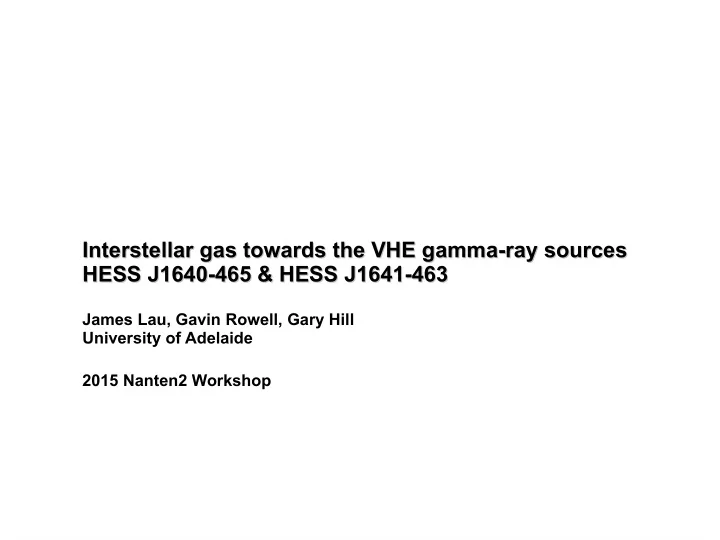

Interstellar gas towards the VHE gamma-ray sources Interstellar gas towards the VHE gamma-ray sources HESS J1640-465 & HESS J1641-463 HESS J1640-465 & HESS J1641-463 James Lau, Gavin Rowell, Gary Hill University of Adelaide 2015 Nanten2 Workshop
Introduction Introduction HESS J1640-465 & HESS J1641-463 ● Luminous TeV gamma-ray sources discovered by H.E.S.S. – True nature of the sources are still being debated – Hadronic, leptonic or combination of both? ● HESS group at the University of Adelaide - Radeladio ● Using molecular lines to probe the interstellar medium towards VHE – gamma-ray sources Help reveal the environment theses sources exist in – Morphological matches with TeV emission? – Hadronic interaction between cosmic-rays and ambient medium ●
HESS observations HESS observations HESS J1640-465 ● Discovered as part of a HESS survey of the galactic plane (2006) – Located at l = 338.2, b=-0.02 degrees (Galactic coordinates) – Intrinsic extended with a Gaussian width of 4.3 ± 0.2' (2014) – Aharonian et al. (2005) HESS Collaboration (2014)
HESS observations HESS observations HESS J1641-463 ● HESS observations towards HESS J1640-465 during 2004-2011 revealed – a new TEV source, HESS J1641-463 Source is revealed at high energies – All Significance of 8.5 sigma above 4 TeV ● events E > 1 T eV E > 2 T eV E > 3 T eV E > 4 T eV E > 5 T eV Projected gamma-ray Oya et al. (2013) flux
HESS J1640-465 in X-rays HESS J1640-465 in X-rays XMM Newton ● Slightly asymmetric X-ray source – NuSTAR – recent pulsar detection! ● Pulse X-ray emission detected with a period of 206 ms – Gotthelf et al. (2014) Funk et al. (2007)
HESS J1641-463 in X-rays HESS J1641-463 in X-rays XMM-Newton and Chandra Collection of many weak X-ray sources – Oya et al. (2014)
Fermi-LAT observations Fermi-LAT observations Initially found one Fermi source coincident with HESS J1640-465 Reanalysis after discovery of HESS J1641-463 led to discovery of 2 – distinct Fermi sources (coincident with the HESS sources) Lemoine-Goumard et al. (2014)
Low-energy wavelength observations Low-energy wavelength observations Colour: Radio view (MOST 843 MHz) Blue: 610 MHz radio continuum emission Green: 8 μm infrared emission Oya et al. (2013) Red: 24 μm infrared emission Castelletti et al. (2011)
Supernova remnants and distances Supernova remnants and distances HESS J1640-465 & HESS J1641-463 are ● seen towards supernova remnants SNR G338.3-0.0 and SNR – G338.5+0.1 respectively Distance to the SNRs is ~ 10-11 kpc – (via HI observations) in the Norma II spiral arm 11 kpc along this line of sight ● corresponds to a Vlsr of ~ -45 km/s Kothes and Dougherty, 2007
Nanten CO survey data Left: Integrated 12CO(1-0) between -68 and -12 km/s Right: 12CO (1-0) spectra in regions towards HESS J1640-465 and HESS J1641-463
MopraCO survey data MopraCO survey data ● 12CO(1-0) data from the Mopra Galactic Plane CO survey. ● First-look data cubes courtesy of Burton et al. Above: Integrated 12CO(1-0) between -68 and -12 km/s Right: 12CO(1-0) spectra of regions towards HESS J1640-465 and HESS J1641-463
MopraCO data MopraCO data -60 to -55 km/s -55 to -50 km/s -50 to -45 km/s -45 to -40 km/s -40 to -35 km/s -35 to -30 km/s Integrated 12CO(1-0) slices
Mopra 7mm data - CS(1-0) Mopra 7mm data - CS(1-0) -60 to -55 km/s -55 to -50 km/s -50 to -45 km/s -45 to -40 km/s -40 to -35 km/s -35 to -30 km/s Integrated CS(1-0) slices
Mopra 7mm data - CS(1-0) Mopra 7mm data - CS(1-0) CS(1-0) spectra of the grided regions Integrated image of CS(1-0) emission indicated in red in the image opposite. between -56 and -16 km/s
Mopra 7mm data Mopra 7mm data Detections in HC3N(5-4), CH3OH and SiO(1-0) Background: Integrated CS(1-0) emission between -56 and -16 km/s
Origin scenario – HESS J1640-465 Origin scenario – HESS J1640-465 Hadronic ● Significant overlap between TeV – emission and north-western part of SNR G338.3-0.0 Spectral shape similar to other – VHE gamma-rays sources identified as SNRs interacting with molecular clouds Hadronic production model – assuming gas density of 150 cm-3 (Lemoine-Goumard et al. 2014) Gamma-ray spectra of HESS J1640-465 Leptonic ● Red – Fermi data points Newly discovered pulsar suggests – Blue – HESS data points that PWN could be in part powering Dashed line - Hadronic production model the TeV source Lemoine-Goumard et al. (2014)
Origin scenario – HESS J1641-463 Origin scenario – HESS J1641-463 Connection between VHE gamma-ray ● spectra & HE gamma-ray spectrum is unclear 2 mechanisms/sources producing – photons in each energy band? VHE hadronic origin ● If SNR G338.5+0.1 were young, – could accelerate particles to required energies. Would require a very hard proton energy spectrum. Gamma-ray spectra of HESS J1641-463 CRs from SNR G338.3-0.0 could – Red – Fermi data points have diffusively reached 1641. Blue – HESS data points Would explain the relative ● Solid lines are best spectral fits to the brightness of J1641 at high respective flux points energies compared to J1640 Lemoine-Goumard et al. (2014)
Current & Future work Current & Future work Mopra observations ● More complete picture of the gas – and its properties towards HESS J1640-465 and HESS J1641-463 Understanding dense gas “bridge” – important for diffusion origin scenario Objective ● Paper detailing all the information – we have gleaned from our Mopra observations. Using this to model & constrain – origin scenarios for both VHE sources CS(1-0) peak velocity map from -150 to 0 km/s (clipped)
Thanks for your attention Thanks for your attention
Recommend
More recommend